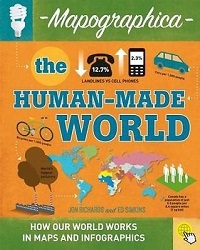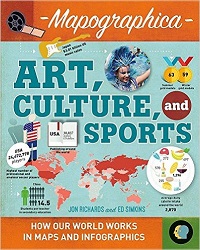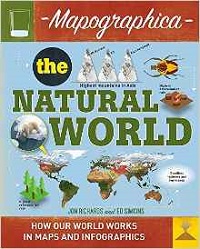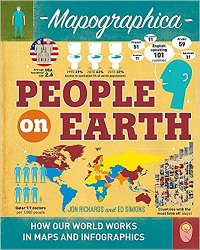| ________________
CM . . .
. Volume XXIII Number 18. . . .January 20, 2017
excerpt:
Calling all infomaniacs! You’re going to love these books. Packed with infographics, maps, illustrations and photos, the “Mapographica: Your World in Infographics” series is sure to be popular with your nonfiction data lovers. The four books in the series examine the world through facts and statistics about “Art, Culture, and Sports”, “The Human-Made World”, “The Natural World”, and “People on Earth”. Authors Jon Richards and Ed Simkins have gathered together an impressive quantity of statistics and presented them in a variety of colourful visual formats that will engage budding statisticians. The good news is that the topics covered in each book are current and relevant to young readers. For example, “In the last five years, sales of smartphones have increased by more than 400 percent.” The bad news is that the relevancy of the topics and the accuracy of the statistics are changing constantly, and some of the content in these books will be out of date quickly. But the value of these books goes beyond their appeal to young number fanatics. In addition to the statistics comparing the longest rivers and the highest mountains are topics that make relationships between the numbers and the people clear. For example, the topic “Wear it Out” looks at what garment workers are paid around the world and how much money is made by the world’s most valuable fashion brands.
The design of the books follows Crabtree’s standard nonfiction format with a table of contents, glossary, index, and a short list of websites, including the CIA website. The books are laid out so that most of the pages are in a portrait orientation, but a few topics are in a landscape orientation so that the books must be physically rotated 90° to be read. But be aware: these are not reference books. No sources are credited for any of the information. Because very few of the statistics are linked to a year, it is hard to know if the information is one year old or 20 years old. When I checked a few of the figures that raised red flags for me, I wasn’t able to verify the accuracy of the numbers. These books should never be quoted as reliable statistical references. Art, Culture, and Sports compares popularity of names, earnings from movies, and the number of soccer players in different countries around the world. If you are curious about the relationship between spending on education and the number of Nobel prize winners in different countries, see pages 18-19, “Great Minds”. The Human-Made World includes topics such as “Internet Access”, “Oil Production”, “Money”, and “Space Launches”. I was disappointed that the CN Tower was not included in the topic “Tallest Buildings”. The topic of “Palm Oil Production” makes the connection between palm oil production and deforestation, including a demonstration of the rate of deforestation.
The Natural World is filled with all the comparisons of natural features of the planet, plus plants and animals. Topics include “Climate”, “Biodiversity”, “Forests”, “Deserts”, “Adapting for Survival”, “Animal Migration”, “Endangered Species”, “Oceans”, “Plates and Quakes”, “Volcanoes”, “Natural Disasters”, and “Climate Change”. People on Earth examines how life expectancy is linked to sanitation levels in different countries, vacation time, education and literacy, diseases and doctors, among many topics comparing life experiences around the world. These books in the “Mapographica: Your World in Infographics” series are worth the shelf space in a library both for the comparisons they present and their general appeal. Since they are sure to be popular, you may want to buy a couple of sets in paperback, rather than one set of hardback books. Highly Recommended. Suzanne Pierson, a retired teacher-librarian, is currently instructing librarianship courses at Queen’s University in Kingston, ON.
To comment
on this title or this review, send mail to cm@umanitoba.ca.
Copyright © the Manitoba Library Association. Reproduction for personal
use is permitted only if this copyright notice is maintained. Any
other reproduction is prohibited without permission.
Next Review | Table of Contents For This Issue - January 20, 2017 |



